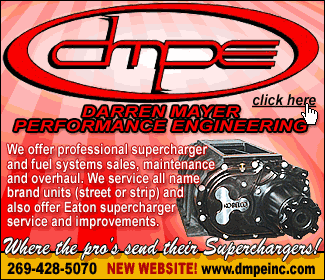| 
 What
are you trying to accomplish through ORSCA? What
are you trying to accomplish through ORSCA?
Fenn: First,
I wanted to bring some stability to it in the
record department because basically, anything
can happen in one run, a piece of paper can
blow in front of the lights, or anything. Because
I’ve seen cars go 4.40s and everyone
just knows that ain’t right, so nobody
claimed it as a record, but if it was close
enough [to be believable] they claimed it.
But if you do it twice in a day, then count
it. That’s why when we started our series
we said you’d have to back up the records.
I also sent tech men to NHRA to be certified
so they can look at these cars and make sure
that they do conform to the rules. Those are
the kinds of things in racing that make it
better.
 Have
you encountered people who claim that by organizing
this it’s not outlaw anymore? Have
you encountered people who claim that by organizing
this it’s not outlaw anymore?
Fenn: Yeah,
yeah we have. And I agree with that in a sense.
I miss the days when we all got together at
the back of a pick-up truck and decided to
go racing, but if we’re ever going to
bring this up to a level where it can survive
and compete with other forms of racing, it’s
got to be brought to a level where we can entertain
sponsors.
 You
mention sponsorship, but earlier you said you
like the clean, street-car appearance of the
Outlaw cars. Do you plan to maybe give up the
rear quarter panel or some other bodywork for
sponsorship space? You
mention sponsorship, but earlier you said you
like the clean, street-car appearance of the
Outlaw cars. Do you plan to maybe give up the
rear quarter panel or some other bodywork for
sponsorship space?
Fenn: That’s
been mentioned and I do eventually see that
we’re going to have to do something like
that. This year, our rules allowed one main
sponsorship decal on the windshield or the
hood scoop, so we’re starting to see
that we’re going to have to do something.
Maybe find smaller companies that can’t
afford the amount of money it takes to get
involved in NHRA these days. They could do
it for pennies on the dollar with Outlaw and
still hit a pretty good crowd. Sponsorship
is the rough part, and that’s what we’re
working on right now.
 Beyond
sponsorship, what’s the biggest challenge
of presenting a series like ORSCA? Beyond
sponsorship, what’s the biggest challenge
of presenting a series like ORSCA?
Fenn: Scheduling.
Getting tracks to put together a good schedule
and sticking to it, because there’s a
lot of jumping around and breaking the car
counts up. The one thing that I see that hurts
this Outlaw deal all around, is booking on
top of each other. It pulls fans in different
directions and it pulls racers in different
directions. It gives no unity to the sport.
 What
advantage does ORSCA bring to fans? What
advantage does ORSCA bring to fans?
ADVERTISEMENT
 |
Fenn: There
was one thing that I could not stand at those
old outlaw races. I would look around at 10:30
on Sunday night and we’d be in the second
round and no fans were left in the stands.
They would go on my web site the next day going, “Who
won the race? Who beat who?” I
mean, to get fans to travel to see a race,
sometimes two and three hours from home, you’ve
got to give them a show in a timely manner.
They don’t want to stick around until
midnight or later and still face a two- or
three-hour drive home. The races have to be
run in order; they have to be run in a timely
fashion, and they’ve got to have a look
of professionalism to them. I spent a lot of
money setting up ORSCA and it has not made
a whole lot of money so far, but with the right
things done well, I think it will.
 Regarding
professionalism, one of the knocks on the Outlaw
class has always been that they’re no
good at getting to the staging lanes on time.
How do you address that and get beyond the
mentality some have that they always have to
go last? Regarding
professionalism, one of the knocks on the Outlaw
class has always been that they’re no
good at getting to the staging lanes on time.
How do you address that and get beyond the
mentality some have that they always have to
go last?
Fenn: Well,
that there goes back to the conformity that
I was talking about. If these guys know they’re
always going to go after Limited Street runs,
they’ll be there. If they’re sitting
in the pits listening to the intercom make
first call, second call, last call, and then
you have five more last calls, they’re
going to take advantage of that. With these
Outlaw cars, the track can change so much for
10-inch tires that it can pay for a smart racer
to lay back and watch what happens when a few
cars go down the track. If he has to, he can
jump under his car and make a little adjustment
to help him get down the track.

|